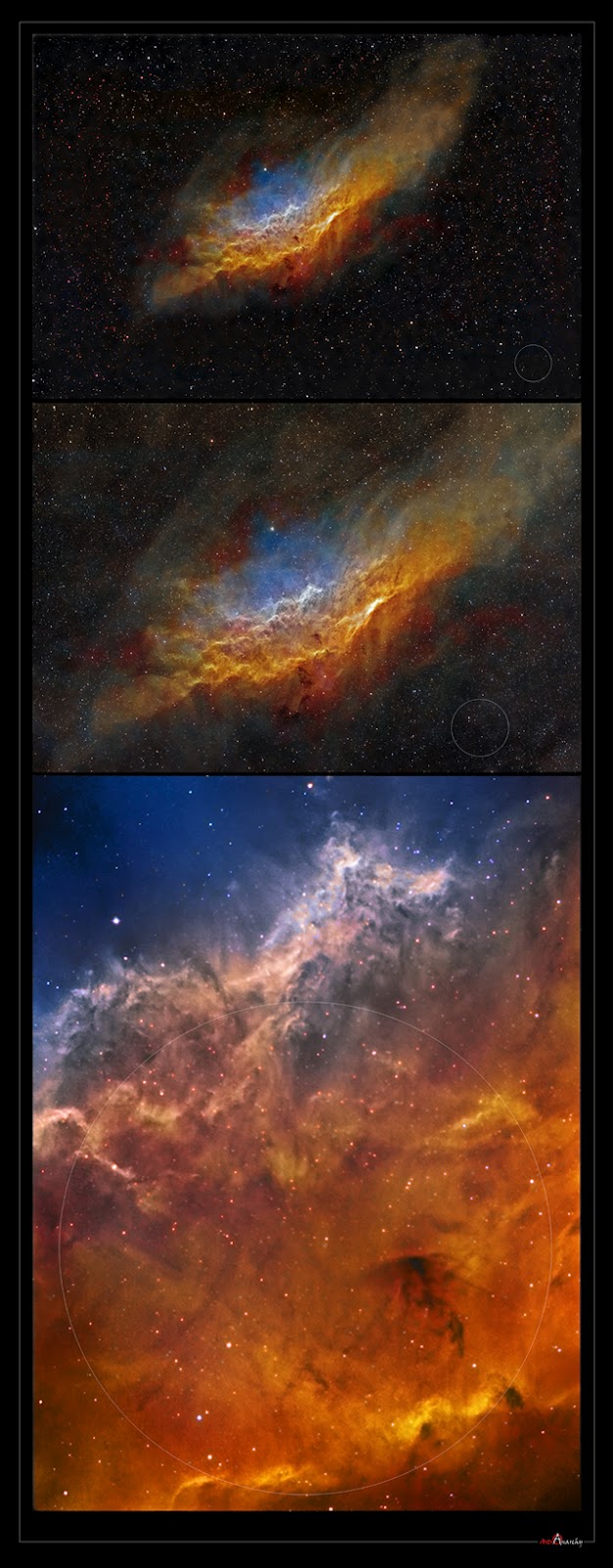COPYRIGHT, PLEASE NOTE
All the material on this website is copyrighted to J-P Metsavainio, if not otherwise stated. Any content on this website may not be reproduced without the author’s permission.
BUY A MUSEUM QUALITY POSTER
BUY A POSTER:https://astroanarchy.zenfolio.com/
Saturday, January 25, 2020
A deep view to the California Nebula in mapped colors
beautifully rounded stars.
The very same optics with a camera, that has a very small pixels, will give a resolution of around one arcsecond / pixel. With same optical configuration, 300mm f2.8, system that has spatial resolution of 1 arcsecond / pixel is 36 times slover, than same optics with large pixels and spatial resolution of 6 arcseconds / pixel.
California Nebula, a deep view to the NGC 1499
Please, click for a full size image
Image is in mapped colors, H-alpha = Green, S-II = red and O-III = Blue.
Image is in mapped colors, H-alpha = Green, S-II = red and O-III = Blue.
This is a very deep image, I haven't seen those extended shapes at upper right and around the brighter nebula before. I have published the same image in visual color palette, it can be seen here, https://astroanarchy.blogspot.com/2020/01/deep-view-to-california-nebula-ngc-1499.html
A closeup
Please, click for a full size image
A very good resolution for the 300mm camera lens
An experimental starless version
Please, click for a full size image
Various shapes in nebula are easier to see when stars are removed.
INFO
A closeup
Please, click for a full size image
A very good resolution for the 300mm camera lens
An experimental starless version
Please, click for a full size image
Various shapes in nebula are easier to see when stars are removed.
INFO
The California Nebula is an emission area located in constellation Perseus. It appears to resemble outlines of State of California on long exposure photographs, like this one. It has a very low surface brightness and it's very difficult to observe visually. Distance from my hometown Oulu, Finland, is about 1000 light years.
this image spans around five degrees horizontally. The Wikipedia article states, that the angular size is about 2,5 degrees (Five full Moons side by side) but as can be seen in this image, the actual size, with a dim outer parts, is much large.
H-alpha exposure alone
Please, click for a full size image
Technical details
Processing workflow
Image acquisition, MaxiDL v5.07.
Stacked and calibrated in CCDStack2.
Deconvolution with a CCDStack2 Positive Constraint, 33 iterations, added at 50% weight
Color combine in PS CS3
Levels and curves in PS CS3.
Imaging optics
Tokina AT-x 300mm f2.8 camera lens
Mount
10-micron 1000
Cameras, filters and guiding
Imaging camera Apogee Alta U16 and Apogee seven slot filter wheel
Guider camera, Lodestar x 2 and an old spotting scope of Meade LX200
Astrodon filters,
5nm H-alpha 3nm S-II and 3nm O-III
Total exposure time
H-alpha, 7 x 1200 s, binned 1x1 = 2 h 20 min.
O-III, 2x 1200 s, binned 2x2 = 40 min.
S-II, 2x1200 s binned 2x2 = 40 min.
The apparent scale in a sky
Please, click for a full size image
This is a large object
NOTE, the apparent size of the full moon is marked in all of the images above.
The angular dimension of the moon is 30 arcminutes, that's 0,5 degrees.
More info about this photo from the year 2012 here, https://astroanarchy.blogspot.com/2012/02/california-nebula-ngc-1499-with-some.html
Subscribe to:
Post Comments (Atom)














No comments:
Post a Comment